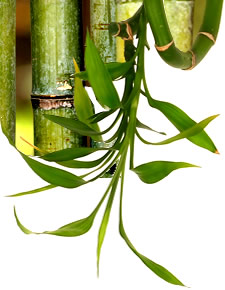

Learn how to bamboo |
When it comes to plants with impact, bamboos have no equal. They can grow 4 feet in one day, screen from view a neighbor's looming two-story house within a few years, or transform a traditional backyard into an exotic retreat. True, some rampant growers, like golden bamboo (Phyllostachys aurea), send out runners into every corner of the garden and beyond; they've given the bamboo clan a bad rap. But the number of garden-worthy species has continued to expand, thanks to a handful of passionate collectors and specialty nurseries that have introduced species from Africa, Asia, Australia, and South America. This diverse group of true grasses, native to tropical and temperate rain forests as well as dry chaparrals, contains more than 1,000 species. Plants range from short groundcovers to 55-foot-tall giants. Some grow in tight, upright clumps, others in graceful, arching clusters. Still others send up widely spaced stems (also called culms) and form open groves you can wander through. Leaves may be short and cluster like fluttering butterflies around the nodes--the ringlike joints along the stems--or they may grow more than a foot long. There's a bamboo suited to almost every Western climate. Some are very hardy (to -15[degrees] or -20[degrees]); others are damaged at 20[degrees]. Varieties that grow as understory plants in nature prefer shade, while others thrive in full sun. Running bamboos can form beautiful groves; clumpers make dramatic focal points. Use the guide on page 116 to choose a bamboo that's right for your garden. Plant bamboo in rich, well-drained soil. Water deeply and regularly (when the soil is just slightly damp to the touch about 4 inches below the soil surface). Apply a high-nitrogen fertilizer two or three times a year between spring and fall, or according to package directions. Any lawn fertilizer will do (such as a 16-6-8 formulation). To create open groves, thin out some old stems once plants are well established. To produce the largest stems on established plants, cut out the thinnest, weakest new shoots each spring. RELATED ARTICLE: Runners or clumpers? Clumping bamboos have short roots; clumps expand by only a few inches per year. Running bamboos send out rhizomes (underground stems) that travel sideways in the top 2 to 18 inches of soil, some varieties wandering many feet from the mother plant. Running bamboos fill in quickly and are best for long screens, hedges, or groves. Most are cold-hardy. The plants need to be contained with barriers (see above) or they'll take over your yard. Use barriers made of flexible polyethylene 30 to 40 millimeters thick (60 mil for very aggressive types) and 22 to 28 inches deep. Install the barrier around the planting's perimeter, leaving a 3-inch lip protruding above-ground; overlap and clip the ends together with a fastener or by using galvanized bolts and polyethylene-compatible glue. If rhizomes "jump" over the exposed top of the barrier, cut them off. Clumping bamboos make excellent focal points or attractive small screens. These kinds need an area 3 to 10 feet in diameter to develop fully but don't need root barriers. Those listed on page 116 are slow to moderate growers. Most are frost-tender, suited for garden use only in mildest climates. |
© Copyright yayixm.com All rights reserved. Unauthorized duplication in part or whole strictly prohibited by international copyright law. |
|
|